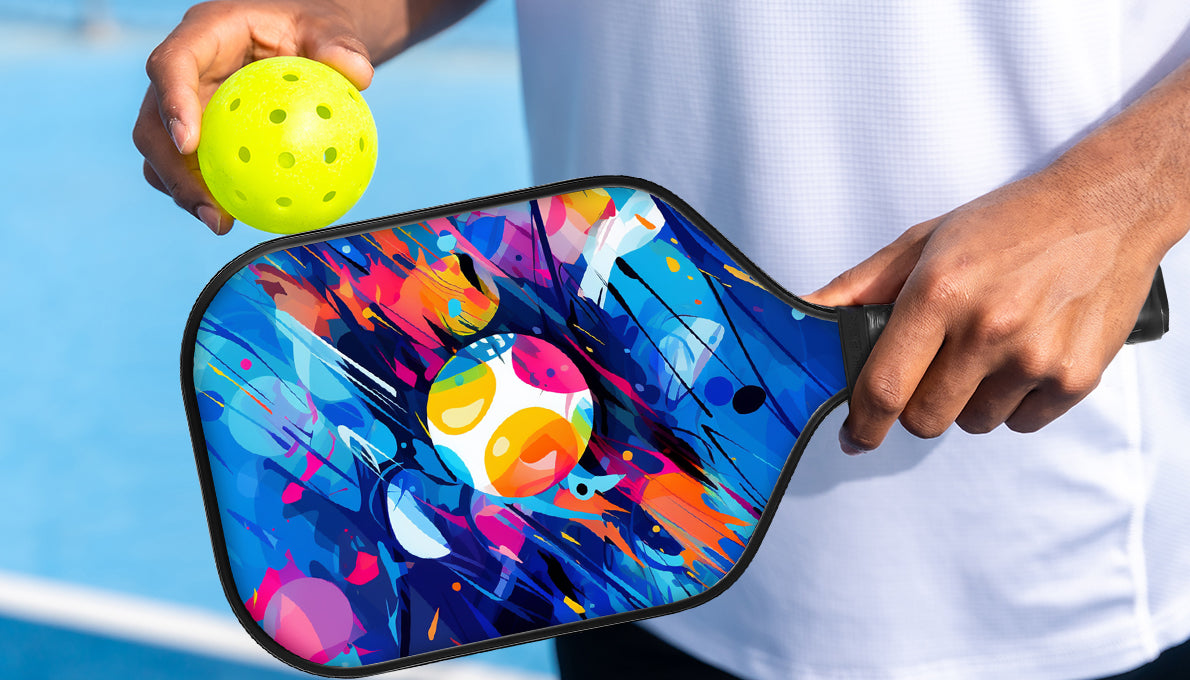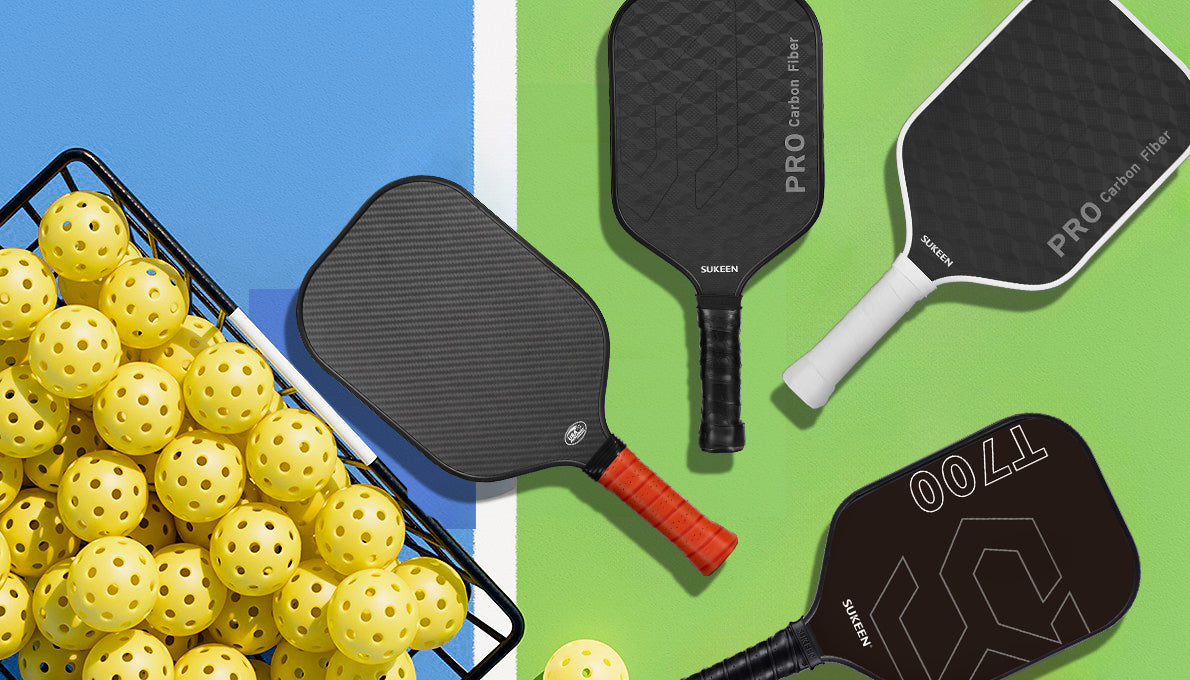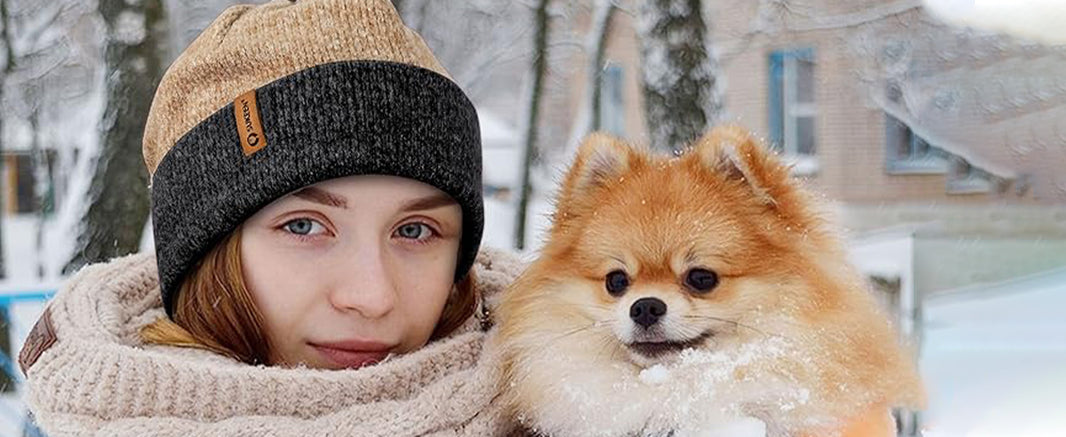How to Play Pickleball?
Ⅰ. Basic Rules of PickleballⅡ. Basic Serving RulesⅢ. Common Mistakes and SolutionsⅣ. Basic Skills of PickleballⅤ. Two-Bounce RuleⅥ. How to Play Pickleball More Happily?Ⅶ. Required EquipmentⅧ. Pickleball TerminologyⅨ. Conclusion
It is said that pickleball is very easy to learn, but how to play it? Don't worry, I will use my years of experience in pickleball to tell you how to play and how to have more fun! Are you ready? Let's unveil the mystery of pickleball together.
Ⅰ. Basic Rules of Pickleball
Pickleball is a sport that combines the characteristics of tennis, badminton and table tennis. It is similar to these racket sports, but has its own unique charm. Here are some basic rules:
Venue
Pickleball is a sport that combines the elements of tennis, badminton and table tennis. Its venue is exquisitely designed to adapt to both family entertainment and formal competitions. The standard Pickleball venue size is 20 feet wide (about 6.1 meters) and 44 feet long (about 13.4 meters), the same as the doubles badminton court. These dimensions are suitable for singles and doubles competitions. If you want to learn more about the similarities and differences between pickleball and other racket sports, you can read "Differences Between Pickleball and Racquet Sports like Tennis".

1. Venue layout
The layout design of the venue not only helps the fairness of the game, but also improves the smoothness of the game. The main layout includes the following parts,
Net
The net is 34 feet (about 0.86 meters) in the middle and 36 feet (about 0.91 meters) at the edge. The net divides the court into two symmetrical halves.The lower edge of the net is in contact with the ground to ensure that the net is stable and the net rope is tight.
Kitchen
The length and width of the kitchen,7 feet (about 2.13 meters) from the net and the same as the width of the court, 20 feet (about 6.1 meters), is an important area in the pickleball court.
In the kitchen, players cannot hit the ball directly back to the opponent's court before the ball lands. At any time, if the player's feet or any part of the body touches the kitchen, no volley can be made. If the ball bounces in the kitchen, the player can enter the kitchen to hit the ball. At this time, the hit must be completed after the ball lands and bounces.
Serving Area
Each half of the court is divided into the left and right serving areas, which are divided by the center line.Each serving area is 10 feet wide (about 3.05 meters) and 15 feet long (about 4.57 meters), and the area between the non-volleying area line and the bottom line.
When serving, the ball must enter the opponent's serving area diagonally. The serve must be made from below the waist, and the ball must fall in the opponent's serving area to be valid.
Sidelines and Baselines
The sidelines are 44 feet long and mark the width of the field. The baselines are 20 feet wide and mark the length of the field.
2. Area around the court
In order to ensure the smooth progress of the game, a certain amount of free space needs to be left around the court for players to move and for safety considerations.
Clearance behind,at least 6 feet (about 1.83 meters), ideally 10 feet (about 3.05 meters).
Clearance on the side,at least 3 feet (about 0.91 meters), ideally 5 feet (about 1.52 meters).
Ⅱ.Basic Serving Rules
Serving Position
The server must serve from within the serving area and must not step on the side or baseline of the serving area.
The ball must be hit from below waist height.
Serving Direction
The serve must be diagonally into the opponent's serving area and must land in the opponent's serving area.The ball must pass over the net in the air without touching the net.
Serving Action
The serve must be made with an underhand stroke, that is, the racket head cannot be higher than the wrist when the racket hits the ball.The server's feet cannot cross the baseline or the side of the serving area.
Serving Order(Single Double)
In singles, the server becomes the new server after each point. The server will serve from the right serving area.
In a doubles match, one side starts serving from the right serving area. After that, the servers take turns to serve, with each player serving once. The servers take turns to serve until one side loses the right to serve (for example, a mistake or the other side scores). After losing the right to serve, the right to serve is given to another player on the other team. This rule is clearly introduced in the USAPA , and you can go there to read it.
When practicing serving, be patient and persistent, and gradually master the correct serving skills and rules. Communicate and learn more with other players, observe their serving skills, and find a serving method that suits you. Keep practicing and adjusting to ensure that you can play stably in the game and improve your competitiveness in the game. Beginners often use rackets during practice, so they need to choose rackets with better durability. Carbon fiber and fiberglass rackets from SUKEEN are extremely durable, and their performance is far superior to other rackets at the same price. I usually recommend their fiberglass rackets to beginner friends around me.
Ⅲ. Common Mistakes and Solutions
1. Stepping on the line when serving
Problem
Beginners tend to not pay attention to the position of their feet when serving, causing them to step on the sideline or bottom line of the serving area.
Solution
Before serving, confirm your position, keep one foot in the serving area, and move the other foot slightly back to ensure that you do not step on the line when hitting the ball.
2. Incorrect serving height
Problem
When serving, the racket hits the ball at a height higher than the waist, resulting in an invalid serve.
Solution
Practice low-hand serving to ensure that the racket head is lower than the wrist when hitting the ball. You can tie a strap at the waist to help judge the serving height.
3. Touching the net when serving
Problem
When serving, the ball hits the net, causing the serve to fail.
Solution
Practice serving strength and angle to ensure that the trajectory of the ball is higher than the net when serving, but does not fly out of the serving area. You can set up markers in front of the net to help adjust the height and angle of the serve.
4. Incorrect serving direction
Problem
When serving, the ball does not land in the opponent's serving area, or the serving direction is incorrect.
Solution
Practice aiming at the opponent's serving area. You can place a target object (such as a basket) in the opponent's serving area and try to serve the ball several times until you can stably serve the ball near the target object.
Ⅳ. Basic Skills of Pickleball
Mastering basic skills is the key to improving the level of competition. Here are some important skills,
1. Grip method
The grip method directly affects the control and accuracy of the shot. Common grip methods include Eastern grip and Continental grip. Eastern grip is suitable for a variety of shots such as forehand and backhand shots, allowing players to easily adjust the angle and power of the shot. Continental grip is a grip method used for specific types of shots, which is usually used for volleys and serves in pickleball. The choice of grip greatly affects the experience of pickleball. SUKEEN's silicone non-slip grip is very soft and has a good touch. It can effectively reduce hand fatigue, making it more comfortable to hold the racket. At the same time, it is designed with special textures or bumps to increase the non-slip properties of the grip. To learn more about how to hold a racket, read "How to Hold a Pickleball Paddle ?", which describes in detail the different grips.
2. Batting skills
Volley
Volley refers to hitting the ball softly and at a low speed near the net, with the goal of putting the ball in a position that is difficult for the opponent to deal with. It is usually used to control the rhythm of the game and force the opponent to make mistakes.
Forehand backhand
Forehand backhand refers to hitting the ball with greater power and speed, aiming to create pressure and direct scoring opportunities through acceleration and strong hitting. It can be performed anywhere on the court, usually away from the net to better exert power. With a higher hitting angle and speed, the ball moves through the court at a faster speed. Compared with volleys, forehand backhands can change the rhythm of the game and the opponent's expectations, increasing tactical diversity.
Ⅴ. Two-Bounce Rule
In pickleball and similar ball games, Two-Bounce means that each shot must return after the opponent's shot and bounce once on your own court. This rule ensures the fairness and dynamics of the game and prevents overly fast counterattacks. This is a rule used to control the pace and strategy of the game.
In some other sports, such as pickleball and similar sports, Double-Bounce means that after throwing or hitting the ball, the ball must bounce at least twice before it touches the ground before it is considered valid. This rule is designed to add technicality and strategy to the game, because players must precisely control the bounce path and position of the ball to ensure that the ball lands legally.The Two-Bounce rule is listed as Rule 7.A, while Double-Bounce is a mistake rule 7.E
For more information, please visit the USAPA official website.
Ⅵ. How to Play Pickleball More Happily?
Pickleball is a highly social sport, and playing with others can make you have fun beyond hitting the ball! Here are some tips on how to make the sport more enjoyable.

1. Learn about local community events
Find nearby pickleball clubs, community centers or sports venues to find out their regular events and competitions. This information can usually be provided through Internet searches, social media or local sports facilities.
2. Participate in beginner classes and practice
If you are a beginner, you can take part in beginner classes and practice offered by clubs or community centers. These classes are usually taught by experienced coaches or players, helping you quickly improve your skills and meet new people.
3. Actively participate in social activities
Attend social events organized by clubs or communities, such as dinners, parties, or charity events. These events are not only a good opportunity to meet new people, but also enhance your sense of belonging to the pickleball community.
4. Join online social groups
Join discussion groups or groups on social media platforms or online communities related to pickleball. This allows you to exchange experiences with other players, get information about competitions and events, and expand your social circle.
Ⅶ. Required Equipment
Having good equipment is an important prerequisite for starting pickleball. The quality of the equipment has a great impact on your sports experience,
Paddle
In pickleball, the most important role is the racket. SUKEEN's carbon fiber and fiberglass rackets are recommended. They are lightweight and durable, and are very suitable for players of different levels.If you want to learn more about how to hold a pickleball paddle, check out "How to Hold a Pickleball Paddle ?".
Ball
The second is pickleball ball, which is divided into indoor and outdoor balls. SUKEEN's indoor and outdoor balls are very popular. They meet the competition standards, so many competitions will use their balls to provide players with competitions.
In addition to these essential equipment, they also sell cooling products that are urgently needed during sports, such as SUKEEN Cooling Towels, Hats, etc., which can help you stay in the best condition during the game. These rich products save a lot of time for us players to choose!You also can read "How to Choose a Pickleball Paddle?".
Ⅷ. Pickleball Terminology
Knowing some common terms can help you better understand and participate in this sport. Here are some common Pickleball terms.
1. Basic Terms
Baseline --The lines at both ends of the court.
Sideline--The lines on both sides of the court.
Non-Volley Zone--Also known as the "kitchen area", the area 7 feet away from the net, no volleys are allowed.
Service Court--The area for receiving serves, including the left and right half areas.
2. Serving related terms
Serve--The hitting action at the beginning of the game must be initiated from behind the baseline.
Drop Serve--Allows players to hit the ball after dropping it to the ground when serving.
Foot Fault--When serving with your foot on the line or over the baseline.
3. Game related terms
Rally--The continuous hitting of the ball from serving to fault.
Side Out--Losing the right to serve.
Dink--A short ball that hits the ball gently into the non-volley area.
Volley--Hit the ball back before it hits the ground.
Lob--Lob the ball high and let it fall into the opponent's backcourt.
Smash--A shot that hits the ball hard toward the opponent's court.
4. Advanced Terms
Spin--Adding spin to the ball, causing it to change its trajectory. If you want to learn more about spin, read the Best Spin Rackets, which also provides advice on choosing a racket.Regarding spin, you can read "Master the Secret of Spin Ball" for a deeper understanding!
Topspin--Spin the ball forward, causing it to accelerate after it hits the ground.
Backspin--Spin the ball backward, causing it to slow down or rebound lower after it hits the ground.
Drive--A powerful flat shot, usually used for offense.
Drop Shot--A light shot that hits the ball just over the net and drops quickly.
5. Other Terms
Paddle-- An implement used to hit the ball, usually made of composite materials or wood.
Double Bounce Rule-- The first shot after serving and receiving must be hit after the ball lands.
Fault--Violation of the rules, including serving errors, foot fouls, etc.
Let--When serving, the ball touches the net but still enters the opponent's serving area, and it can be re-served.
Sweet Spot--An ideal hitting area on the surface of the racket. When the ball hits this area, you can get the best control and ball speed."Pickleball Paddle Sweet Spot Guide"The article has a detailed introduction to this aspect.
Mastering these terms will not only improve your understanding of the pickleball sport, but also help you communicate and cooperate better in the game. Understanding and using these terms can make your pickleball experience richer and more interesting.
Ⅸ. Conclusion
Pickleball is a sport that allows you to find your own fun and challenges, whether you have rich athletic cells or not, and it has nothing to do with your age. If you want to try, try it! You can also have a pickleball game with your friends in the park on a nice weekend. When you play pickleball with your family and friends, I believe you will definitely gain something precious besides the joy of sports.
Related Articles
What to Look for in a Pickleball Paddle?How to Put Overgrip on Pickleball Paddle?How to Clean and Maintain Pickleball Paddle?How to Add Texture to the Pickleball Paddle? How to Choose a Pickleball Paddle?








